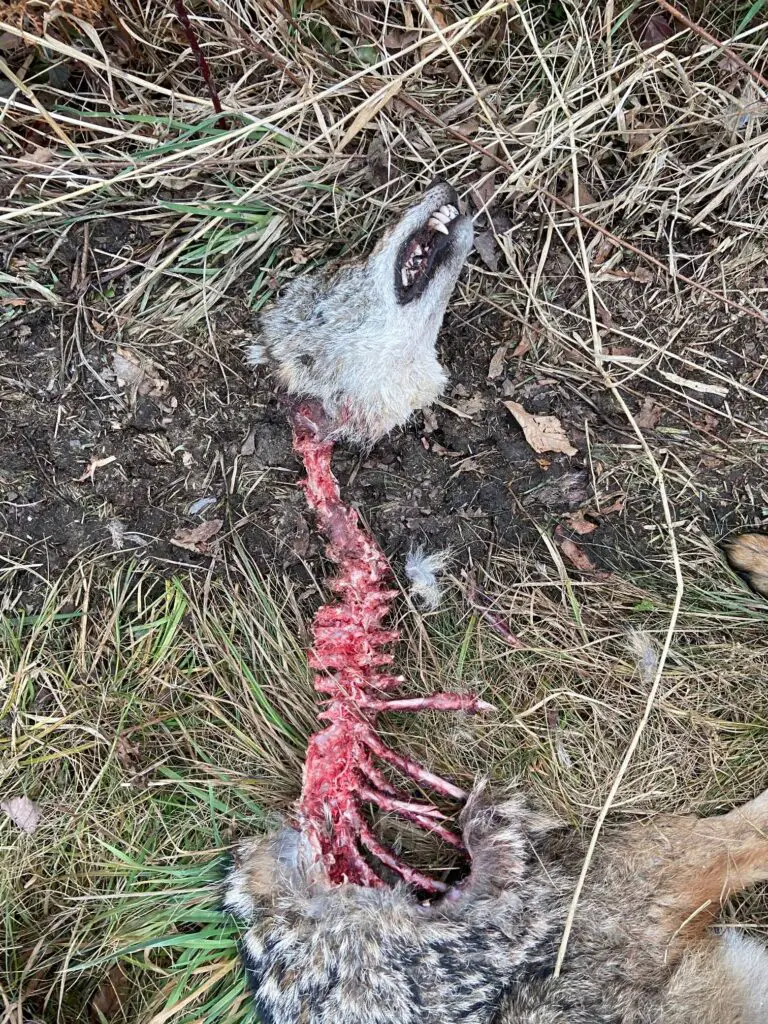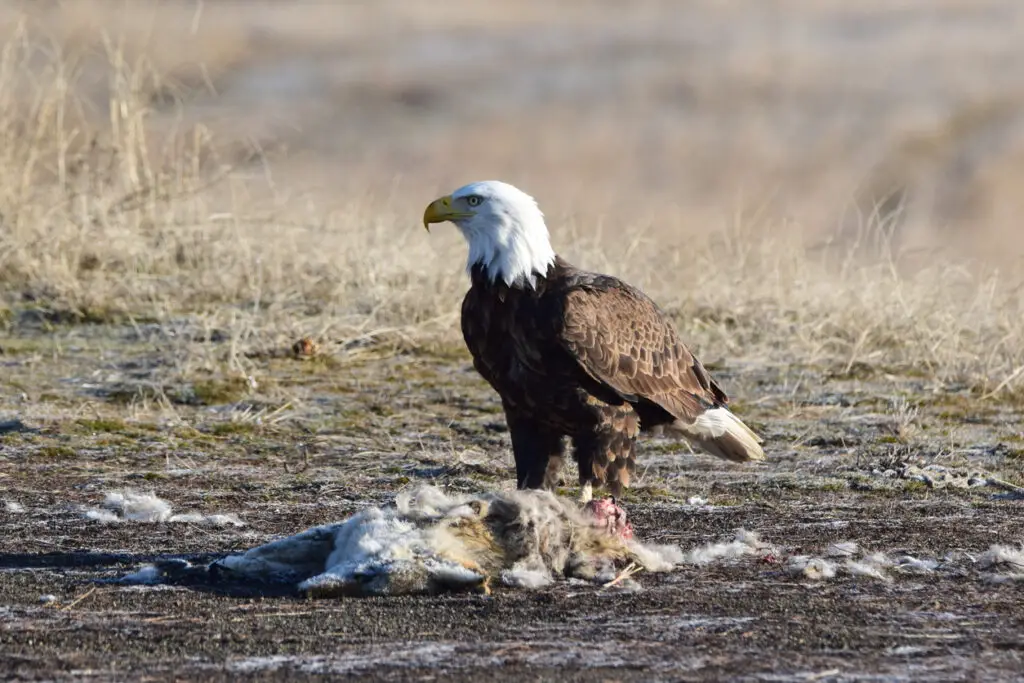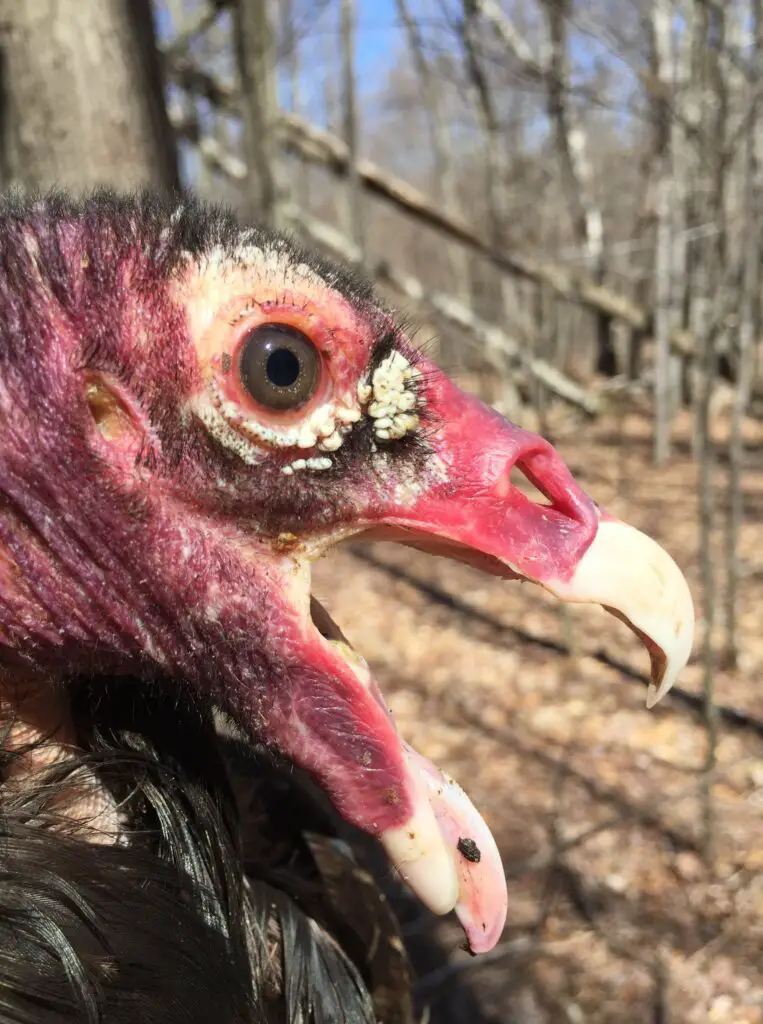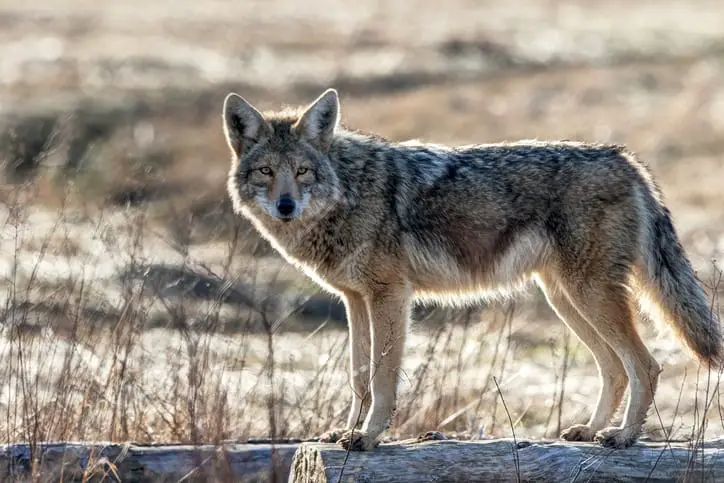Living anywhere near Eastern Coyotes, one wonders, what eats coyotes? In New York, our eastern coyote is a large apex predator. The idea that there may be coyote predators that hunt these swift-footed, 50-plus-pound carnivores is a little hard for most folks to believe.
But recent events here in New York have reminded us all that coyote predators exist. And unlike all the other animals that eat coyotes, these animals will kill off or drive out most, if not all, of our state’s resident coyotes. And though they have been gone for a long time, these long-considered vanquished animals are quickly returning.
And if any of our eastern coyotes decide to take up residence in another state, they may not fun complete safety there. Many states have at least one group of animals that eats coyotes, even if they are nothing more than targets of opportunity.
Related: Can you have a coyote as a pet?

What eats coyotes?
There are two types of animals that eat coyotes, scavengers and coyote predators.
Animals that eat coyotes as prey are nonexistent. Those that eat coyotes as carrion include wolves, brown and black bears, golden and bald eagles, mountain lions, alligators, and vultures. Coyotes don’t have any predators. Coyotes killed by other animals are killed due to a territorial dispute.
Some caveats here:
Wolves prey on coyotes but do not eat them as a food source. Wolf attacks on coyotes are all about the domination of the coyotes. The vicious encounters you’ll find on youtube are more about local competition and essentially not predatory attacks.
Bears will dig out and eat a den of coyote pups, but never pursue adult coyotes as prey.
Alligators do not hunt coyotes as prey. The only photographic evidence of an alligator eating a coyote was one that featured a rotting coyote corpse that was eaten post mortem.
Mountain lions will drive off a coyote in a battle over prey. They too do not prey upon and consume coyotes with any regularity.
Related: Learn how to hunt coyotes at night.

What eats coyotes that are alive?
Very few animals take, kill, and eat coyotes alive. All of them limit themselves to preying upon juvenile coyote pups. Adult coyotes are too fast, intelligent, and cautious to be routinely identified as prey by any other predator species.
Coyote pups, are well protected during their first month, but within 35 days of birth, a coyote pup starts exploring the world outside its den. Everything will be new and different for the next few months, except for its parents’ constant presence and oversight.
The pup is moved to a new location shortly after being weaned and able to kill and eat its own small prey. After providing the perfect sanctuary, the den is forever abandoned, never to be returned to by this pup.
The coyote pup will never again live below ground unless it is female. To ready it for its new lifestyle, mom and dad will take it to areas like fields with tall grasses and the edges between tree lots and open plains.
Now is the moment in time when predators like eagles have their best chance to prey upon coyotes. Sometime before the pups begin to accompany their parents on short hunts, they are incredibly vulnerable to the keen-eyed eagles circling above.
Related: What is coyote life like on a day to day basis?
Wolves do not eat coyotes.
Despite much of what you may have heard, wolves are not a significant coyote predator. When wolves do kill coyotes, they are usually transient coyotes.
Transient coyotes are unaccompanied coyotes that do not belong to a group. Usually, these yearlings have recently been driven from their family unit. Transient coyotes are primarily engaged in seeking a mate and establishing thier terriroies. Transient coyotes are not territorial and have a much more extensive range than resident coyotes.
Transient coyotes are victimized by wolves more than resident coyotes because they are more vulnerable to attack and more likely to intrude on a wolf’s territory accidentally.
However, resident coyotes often have territories that overlap with wolves and enjoy the benefit of scavenging wolf kills—especially in the winter.
When a wolf attacks a coyote, its sole purpose is to drive a competitor away from its territory or a carcass. Wolves do not eat coyotes, at least under normal circumstances, and I challenge you to find even a single photo of a wolf eating a coyote.
At worst, wolves drive coyotes out of areas they inhabit or limit their numbers and, therefore, populations number.
Related: Hunting coyotes to protect a farm or ranch.
Coyote Predators: American Black and Grizzly Bears
Bears do not pursue coyotes as prey. Bears do not drive coyotes out of their territories. Bears do not give a damn about coyotes unless they have to scare them off a kill. Anyone who tells you bears stalk and eat coyotes is mistaken or writing for clicks.
Do lynx, bobcats, or mountain lions eat coyotes?
No. See the comments for bears. They compete with coyotes but do not view them as prey.

What really eats coyotes?
The reality is, if you found a partially consumed coyote, a scavenger is the culprit. What killed that coyote? Most likely, a human coyote hunter. Aside from old age and disease, coyote hunting is the number one cause of death for coyotes.
Turkey vultures, raven, and crows make the biggest and fastest dents in coyote remains. Mice and bugs quickly play their part as well.

What is a coyote in the first place?
A coyote is an undomesticated canine native to North America. Its slender muzzle, bushy, low-hanging tail, and pointed ears resemble a camouflaged German Shepard. Intelligent, highly communicative, and designed to adapt and thrive in almost any environment, a coyote is also surplus-killing predator.
The scientific name for the species” Canis latrans” means” barking dog.” There are 19 known subspecies of the coyote. The Canis latrans var (more familiarly known as the Eastern Coyote) is the largest of the subspecies.
Coyote fur colors are varied, often geographically, but predominantly light gray or brownish yellow patches mixed around its body with black and white. A coyote’s eyes are yellow (most domestic dogs are brown). A coyote’s tail often has a black tip at the end and is always carried low when moving at any speed (unlike domesticated dogs).
Coyote tracks are often straight lines (compared to a dog’s meandering path) and are narrower and more elongated than a dog’s. Related: Learn how to read coyote tracks and scat.
Western coyotes have an average weight between 20-25 pounds, while the Eastern Coyoteaverages between 25-45 pounds. The largest coyote ever recorded topped the scales at 75lbs.
What do coyotes eat?
A coyote’s diet will depend on the time of the year and where it lives.
In the winter, coyotes survive on rabbits and deer (often carrion). Studies of the Eastern coyotehave found snowshoe hare in just over 50% of the bellies of coyotes taken. Deer, on the other hand, were found in 31%. Voles make up nearly 2/3 of a coyote’s diet if there is little snow on the ground.
In the spring and summer, along with mice, deer, and rabbits, coyotes will eat a host of insects (especially grasshoppers) and plants.
During the fall, coyotes will happily consume their fill of fruits like plums, berries, and watermelon.
Related: The entire coyote’s diet.
Why are there so many suburban coyotes, because nothing eats them In Paradise.
A comfortable life for a coyote is all about the local habitat. If it has plenty of food and water, suitable places to make dens and raise and rear pups, and no natural predators—it’s perfect.
The suburbs have rabbits, squirrels, and mice—all basic staples of the coyote diet. There are also rich, well-tended gardens and fruit trees. These are delicious treats that are harder to find in the wild. And let’s not forget about the garbage and compost piles. Your leftovers are tastier than any roadside carrion, and your compost pile is more nutrient dense than the plants a country coyotetypically fills half their belly with at each meal.
Heck, some of the friendly people even feed the local coyotes and give them funny names.
As for shelter, that rarely used shed behind your house makes for a perfect place to put a den. If that’s not suitable, there are storm drains, golf courses, and parks with zero human traffic at night to call home.
Raising pups in the suburbs is safer than in a rural area. Mom and dad don’t need to travel far to secure water and food. There are no leg hold traps, snares, or hunters pursuing them. There is traffic, but at night the flow ebbs, and the speed limit is 30 m.p.h.; a hazard easily avoided

